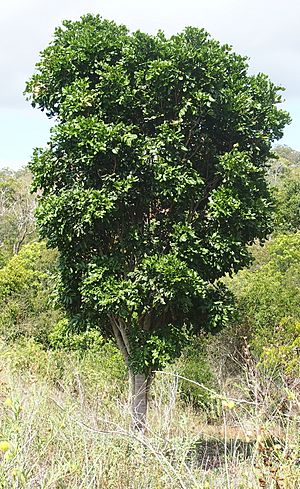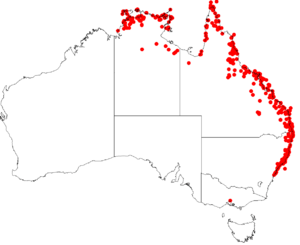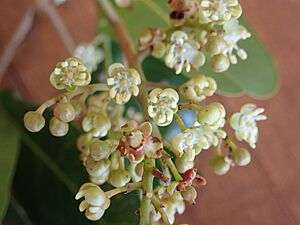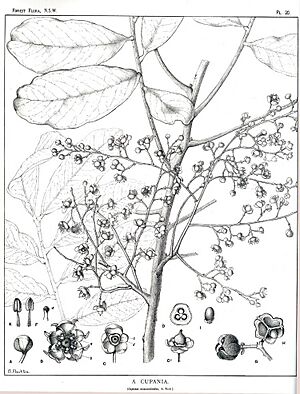Tuckeroo facts for kids
Quick facts for kids Tuckeroo |
|
|---|---|
 |
|
| Cupaniopsis anacardioides | |
| Scientific classification | |
| Genus: |
Cupaniopsis
|
| Species: |
anacardioides
|
 |
|
| Occurrence data from AVH | |
| Synonyms | |
|
Cupania anacardioides A.Rich. |
|
The Tuckeroo (scientific name: Cupaniopsis anacardioides) is a type of flowering tree that belongs to the soapberry family, called Sapindaceae. You might also hear it called carrotwood, beach tamarind, or green-leaved tamarind. This tree naturally grows in eastern and northern Australia, and also in New Guinea.
Tuckeroo trees usually live in coastal rainforests, which are forests found near the sea. They often grow on sandy soil or close to river mouths where fresh and salt water mix. In Australia, you can find them from Seven Mile Beach in New South Wales all the way up to northern Queensland.
Sometimes, the Tuckeroo tree can become an invasive species in other places, like parts of the United States, especially Florida and Hawaii. This means it grows so well there that it can take over and harm the local plants.
Contents
What Does the Tuckeroo Tree Look Like?
Tuckeroo trees can grow quite tall, up to about 10 meters (around 33 feet) high. Their main stem can be as wide as 50 centimeters (about 20 inches). The bark on the trunk is usually smooth and can be grey or brown, often with lines that stick out horizontally. The bottom part of the tree's trunk often has a wider, flattened shape.
Leaves and Flowers
The leaves of the Tuckeroo tree are made up of smaller leaflets, usually six to ten of them. These leaflets are smooth, without any teeth along their edges. They are shaped like an egg or a long oval and are about 7 to 10 centimeters (about 3 to 4 inches) long. The very tip of each leaflet is often flat or has a small notch. You can easily see the veins on both sides of the leaves, and they often stick out on the underside.
Greenish-white flowers grow in clusters on the tree. These flowers usually appear between May and July.
Fruit and Seeds
After the flowers, the tree produces fruit from October to December. The fruit is a round, orange or yellow capsule with three sections. Inside each section, there is a shiny, dark brown seed. What's really cool is that each seed is covered in a bright orange, fleshy layer called an aril. This colorful fruit attracts many birds, like the Australasian figbird, olive-backed oriole, and pied currawong, who help spread the seeds.
If you want to grow a Tuckeroo tree from its seeds, it's quite easy! It helps if you remove the orange aril from the seed and soak the seed in water for a few days before planting.

How People Use Tuckeroo Trees
The Tuckeroo is a very attractive plant. People often use it as an ornamental tree in gardens or along streets. It's especially good for planting in coastal areas because it can handle salty conditions well.
See also
 In Spanish: Tuckeroo para niños
In Spanish: Tuckeroo para niños



